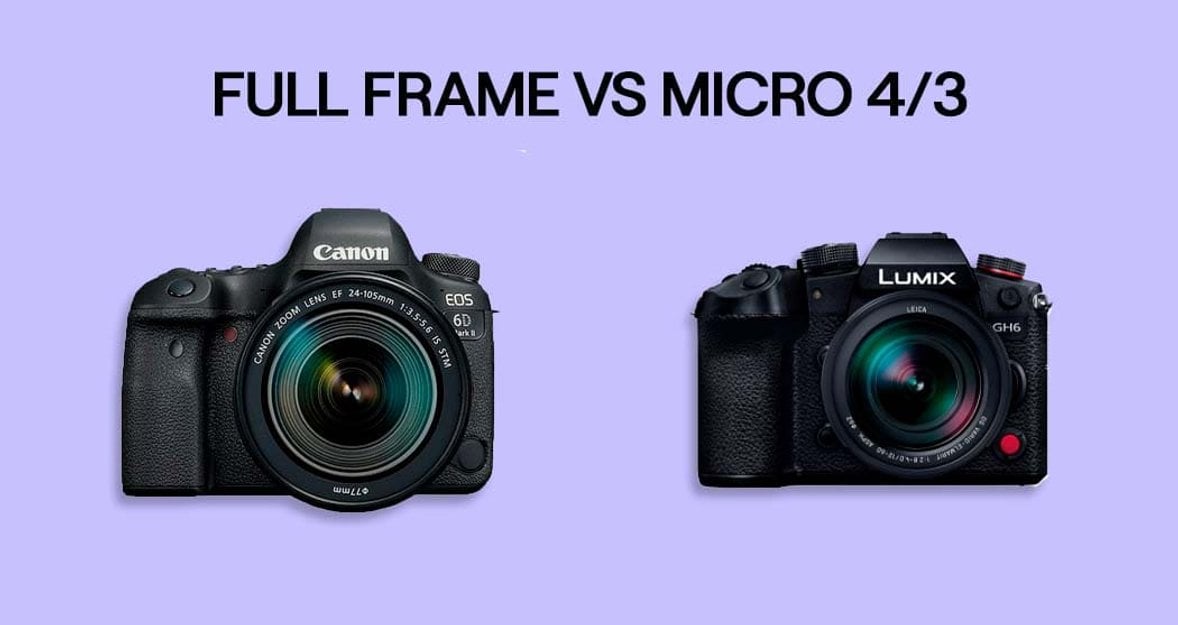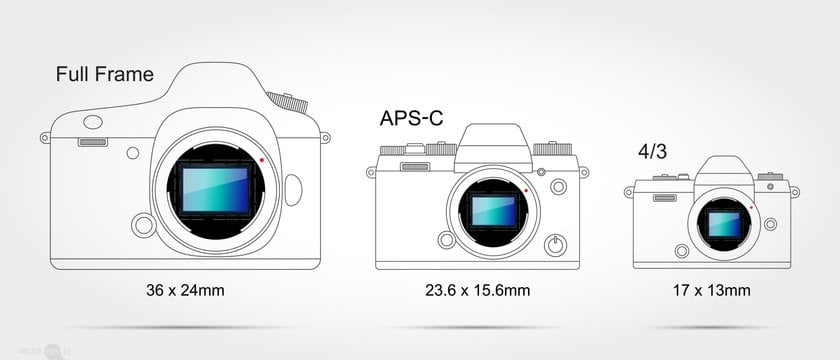Full Frame vs Micro 4/3 Main Differences
October 25, 2024

What is a four-thirds camera, M43, MFT, and APSC? Let's figure it out! Today, in our blog, we answer this question. Stay for more!
It may not seem obvious, but the size of the camera's sensor makes a big difference in digital photography. By understanding the difference between Full Frame, APS-C, and Micro Four Thirds sensors, you can master working with each of them, increasing your professional level.
The size of the sensor affects the sharpness and depth of the photos, as well as the camera's performance in low light. The number of details in the frame, the level of noise, and even the brightness of colors depend directly on this. In addition, the sensor's size and weight affect the camera's size and weight. And this should be considered if you travel the world with her in tow.
Let's unravel the mysteries of camera sensor sizes, from Micro Four Thirds to Full Frame conversion nuances to in-depth Micro 4/3 camera comparisons. Discover how to elevate your shots!
Understanding Camera Sensors
 When choosing a camera, consider the type of sensor it uses. It greatly impacts your photography. Full Frame, APS-C, and Micro Four Thirds are today's most common sensor sizes with unique benefits and drawbacks.
When choosing a camera, consider the type of sensor it uses. It greatly impacts your photography. Full Frame, APS-C, and Micro Four Thirds are today's most common sensor sizes with unique benefits and drawbacks.
Sensor Type | Size | Crop Factor | Pros | Cons |
Full Frame | 36 x 24mm (same as 35mm film) | None | Best for low-light shots. Bigger pixels = more detail and color. Great for professional portraits and landscapes. | More expensive and bulkier. |
APS-C (Cropped Sensor) | 23.6 x 15.6mm (varies slightly) | 1.5x (or 1.6x depending on the brand) | Cheaper and more compact than Full Frame, yet still gives great photos. Popular with hobby photographers. | Low light is not as good as Full Frame. |
Micro Four Thirds (MFT) | 17.3 x 13mm | 2x | Tiny and lightweight. Huge lens choice. Loved by vloggers and travelers. | Struggles more in dim light compared to the others. |
MFT vs Full Frame and M43 vs Full Frame
If we compare, both MFT and M43 are smaller. MFT offers lighter, more compact cameras with a deeper depth of field. M43 is more portable and affordable. Full Frame sensors often give better photos, especially in low light. But they can be pricier and heavier. Choose based on what you'll use it for and your budget!
Micro 4/3 vs Full Frame: What’s the Difference
 Quality of Imagery
Quality of Imagery
Full Frame takes the crown to capture detail due to its larger dimensions. With the ability to soak up more light and its expansive pixels, this size generally triumphs in dim lighting, exhibits a vast dynamic spectrum, and minimizes graininess even when ISO settings spike. Yet, for regular photo enthusiasts, this distinction might only pop out in massive prints or high-caliber projects.
Also read: Understanding HDR Tone Mapping
Blurring the Background
 One of the impressive benefits of Full Frame's greatness is its ability to blur the background significantly. This makes the main objects more visible and bright. This attribute is especially indispensable in portrait shots. However, with modern portrait photo editing technologies, you can achieve the desired background blur in post-processing without spending the budget on a full-frame camera.
One of the impressive benefits of Full Frame's greatness is its ability to blur the background significantly. This makes the main objects more visible and bright. This attribute is especially indispensable in portrait shots. However, with modern portrait photo editing technologies, you can achieve the desired background blur in post-processing without spending the budget on a full-frame camera.
Choices in Lenses
 The world of Micro Four Thirds boasts a large number of custom lenses. Most of the bottoms are extremely miniature and light, ideal for beginners and travelers.
The world of Micro Four Thirds boasts a large number of custom lenses. Most of the bottoms are extremely miniature and light, ideal for beginners and travelers.
On the contrary, full-frame devices expand the horizon thanks to the spectrum of first-class options of premium-class lenses. Despite the professional advantages, they are still bulky and expensive for most beginners.
Size Matters
 Travel enthusiasts and on-the-go photographers might lean towards Micro Four Thirds. Why? Their cameras and associated lenses are typically more compact and weigh less than those aligned with Full Frame.
Travel enthusiasts and on-the-go photographers might lean towards Micro Four Thirds. Why? Their cameras and associated lenses are typically more compact and weigh less than those aligned with Full Frame.
Pocket Concerns
Full-frame сameras can be expensive if cost matters to you. You should think twice before buying a gear because the camera and lens budget may exceed your needs in this particular option. Cheaper options can be found in Micro Four Thirds, which also does not skimp on obtaining excellent image results.
A 4/3 CMOS sensor size is approximately 17.3 x 13 mm, much smaller than a Full Frame (36 x 24 mm). This allows for compact cameras with lightweight lenses and offers a 2x crop factor compared to a Full Frame.
To make the right choice, consider your future shooting plans and portability. In addition, in the era of advanced photo editors with AI functions, such as Luminar Neo, photographers can forget about the worries of blurry pictures or worse-quality frames.
Adaptability
What is a four thirds camera? The feature of Micro Four Thirds cameras is determined by 4/3 sensor size. They are sleeker and have a compact size, which, combined with a wide range of lens options, makes them versatile. They are popular among photographers because they are designed for taking pictures of anything, from bustling streets to calm landscapes. On the other hand, they are inferior to Full Frames in image clarity and prowess in dark conditions. Full Frames are more popular among those who shoot posed portraits, natural landscapes, or studio settings. Depending on your profile and needs, you can choose the favor of one or buy both options for yourself.
Also read:How To Transfer Photos From Camera To Phone
Gazing Through the Lens
 Micro Four Thirds sensors increase by two times, so the 25 mm lens of such a camera will repeat the perspective of the 50 mm lens of its full-frame counterpart. Such a "magnified" view can be used when the shooting objects are far away.
Micro Four Thirds sensors increase by two times, so the 25 mm lens of such a camera will repeat the perspective of the 50 mm lens of its full-frame counterpart. Such a "magnified" view can be used when the shooting objects are far away.
The Role of Luminar Neo in Enhancing Your Photography
 Luminar Neo will help you maximize your camera's potential regardless of its sensor size. The software optimizes the editing process by understanding the nuances of different sensor sizes.
Luminar Neo will help you maximize your camera's potential regardless of its sensor size. The software optimizes the editing process by understanding the nuances of different sensor sizes.
This photo editor enhances the detail and sharpness of images captured by smaller sensors like Micro Four Thirds to match larger sensors' perceived level of detail. Likewise, Luminar Neo can nimbly handle wide dynamic range and color data from full-frame sensors. This advance allows you to make the most of the camera's capabilities.
Exclusive Tools of Endless Possibilities in One AI Editor
Explore Now!FAQ
What's the deal with Micro Four Thirds, Four Thirds, and how do they compare with APS-C?
Both Micro Four Thirds and Four-Thirds refer to sensor sizes. But here's the catch: Olympus and Panasonic teamed up to create Micro Four Thirds specifically for high-end mirrorless cameras. The sensor size is the same as the Four Thirds, but the Micro version is more compact thanks to a smaller lens mount and a shorter lens-to-sensor distance. On the broad spectrum, when comparing APSC vs Micro 4/3, the former is often in the middle in size.
“Crop factor” — sounds techy. What's it about?
Think of crop factor as a way to compare lens views across different sensor sizes, using the Full Frame as the reference point. The micro 4/3 crop factor is 2x, which means that when using a Micro Four Thirds sensor, you're "zoomed in" twice as much as a Full Frame. On the other hand, APS-C sensors have a crop factor that ranges between 1.5x and 1.6x, depending on the manufacturer.
Can I convert Micro Four Thirds to Full Frame?
Technically, converting involves hardware changes, which is different from standard practice. Using adapter mounts can cause vignetting (darker edges in the photo) or limited lens functionality. Simply put, Full Frame captures a broader view than what Micro Four Thirds lenses are designed for.
What is the difference between APS-C and Full Frame?
Full-frame sensors are especially effective in low light. It is the best choice for portrait and landscape photography professionals. Their larger sizes capture more detail and light. In contrast, APS-C sensors are smaller, more affordable, versatile, and suitable for many photography styles. So, is Full-Frame better than APS-C? It depends on individual needs, budget and factors like camera size and lens availability.
How does size matter for image quality and background blur?
Larger sensors are better in low light and can blur the background beautifully for portraits, creating a professional bokeh effect. But if you need sharper shots, like street or landscape photography, Micro Four Thirds and APS-C are your friends.
Why are some cameras called 'mirrorless'? How does that relate to sensor size?
Traditional digital SLR cameras use a mirror to reflect light from the lens into the optical viewfinder. On the other hand, Mirrorless allows light to fall directly on the sensor. The lack of a mirror makes the camera more compact. Such cameras can have different sensor sizes, from full frame to APS-C and Micro Four Thirds. Mirrorless technology gives you a preview directly from the sensor, so often, the body of such a device is lighter and smaller regardless of the size of the sensor!


 Quality of Imagery
Quality of Imagery



